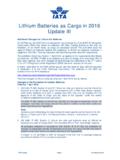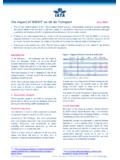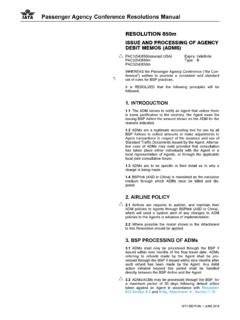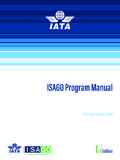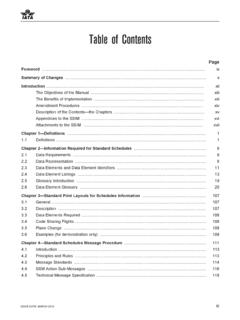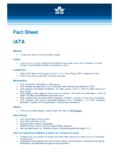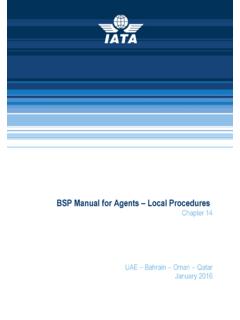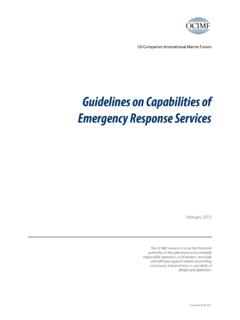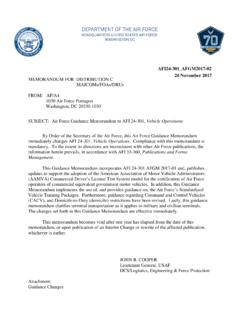Transcription of IATA Guidance on Smart Baggage with integrated …
1 Smart Baggage with integrated lithium batteries and/or Electronics 1st Edition 2017 1 Contents Section 1 Background .. 2 Section 2 Regulatory Requirements .. 2 lithium batteries Passenger / Crew Provisions .. 2 Active Devices .. 3 Quick reference .. 4 Section 3 Recommendations for Operators .. 5 Section 4 Cabin firefighting procedures .. 5 Section 5 Safety Risk Assessment .. 6 Section 6 Device marketing websites .. 6 Smart Baggage with integrated lithium batteries and/or Electronics 2 1st Edition May 2017 Background Recent developments of innovative Baggage with integrated lithium batteries , commonly known as Smart luggage are being marketed and sold to the traveling public.
2 These devices include integrated lithium batteries , motors, power banks, GPS, GSM, Bluetooth, RFID or Wi-Fi technology. The presence of the lithium batteries can contravene various regulatory requirements. These devices require careful attention even if permitted by the applicable regulations. Examples of Smart luggage include features such as: lithium ion battery and motor allowing it to be used as a personal transportation device, either as a stand-up scooter, or sit on vehicle. These devices do not meet the criteria of a mobility device. lithium ion battery power bank that allows charging of other electronic devices such as mobile phones, tablets and laptops.
3 GPS tracking devices with or without GSM capability. Bluetooth, RFID and Wi-Fi capability. Electronic Baggage tags. Electronic lock/s. lithium ion battery, motor and tracking device (GPS) allowing the bag to self-propel and follow the owner. Regulatory Requirements lithium batteries Passenger / Crew Provisions All lithium batteries carried by passengers or crew are subject to the provisions of Part 8, Chapter 1 of the ICAO Technical Instructions. The provisions of the ICAO Technical Instructions are contained in Subsection of the IATA Dangerous Goods Regulations (DGR). The provisions set out in DGR for lithium batteries provide for the following: A.
4 Operator approval not required: a) each installed or spare battery must not exceed: 1. for lithium metal or lithium alloy batteries , a lithium content of not more than 2 g; or 2. for lithium ion batteries , a watt-hour rating of not more than 100 Wh. b) batteries and cells must be of a type that meets the requirements of the UN Manual of Tests and Criteria, Part III, subsection ; c) articles containing lithium metal or lithium ion cells or batteries , the primary purpose of which is to provide power to another device, power banks, and spare lithium batteries are permitted in carry-on Baggage only.
5 Note: Specific security regulations may prevent the carriage of some peripherals, spare batteries and power banks in carry-on Baggage . Smart Baggage with integrated lithium batteries and/or Electronics 3 1st Edition May 2017 B. Operator approval required: a) Each installed or spare battery must not exceed: 1. for lithium metal or lithium alloy batteries , a lithium content exceeding 2 g, but not exceeding 8 g. Only permitted in portable medical electronic devices, 2. for lithium ion batteries a watt-hour rating exceeding 100 Wh, but not exceeding 160 Wh; b) batteries must be of a type that meets the requirements of the UN Manual of Tests and Criteria, Part III, subsection ; c) articles containing lithium metal or lithium ion cells or batteries , the primary purpose of which is to provide power to another device, power banks, and spare lithium batteries are permitted in carry-on Baggage only with a limit of two spare lithium ion batteries per passenger.
6 Note: Specific security regulations may prevent the carriage of some peripherals, spare batteries and power banks in carry-on Baggage . Active Devices All portable electronic devices (PED) carried on an aircraft are subject to specific requirements to ensure that they do not pose a hazard to aircraft systems due to electromagnetic radiation. These provisions are set out in applicable EASA and FAA regulations. The provisions in the regulations are the described in EASA AMC and GM to Part-CAT Issue 2, Amendment 1 or subsequent versions of such Guidance and FAA Advisory Circular AC These documents require the following: a) for PED carried in the cabin by passengers or crew the passenger or crew member is responsible for ensuring that all transmitting functions are turned off at all times during flight.
7 B) for devices carried in or as part of checked Baggage there is a requirement that: 1. The PED must have been demonstrated to meet specific electromagnetic radiation standards and the PED must be approved by the operator (airline). 2. The PED must be designed with a minimum of two independent means to turn off completely, turn off cellular or mobile functions, or a combination of both when airborne. These independent methods must use different sources to identify flight. For example, a PED designed to sense rapid altitude changes and acceleration to turn off cellular transmissions is an acceptable design feature that meets the requirement.
8 Redundant sources of the same information, such as two vertical accelerometers, would not be an acceptable design. Smart Baggage with integrated lithium batteries and/or Electronics 4 1st Edition May 2017 Quick reference lithium batteries * Any spare lithium battery, including power banks that are designed to charge other electronic devices, installed in a Baggage item must be able to be removed from the bag so that the passenger can carry the spare lithium battery / power bank into the cabin. No lithium battery contained in a bag may be considered as installed in equipment The lithium ion batteries must have a power rating of not more than 100 Wh unless the passenger has approval from the operator, in which case the lithium ion battery must not have a Watt-hour rating exceeding 160 Wh.
9 Power banks* Where a lithium ion battery is installed in a bag for the primary purpose of charging other devices, it must be considered as a power bank and comply with existing requirements for carriage of such devices. Tracking systems Tracking devices must comply with FAA Guidance 91-21-c or EASA AMC and GM to Part-CAT Issue 2, Amendment 1 or subsequent versions of such Guidance . Specifically under FAA Guidance : The PED must be designed with a minimum of two independent means to turn off completely, turn off cellular or mobile functions, or a combination of both when airborne.
10 Tracking through passive RFID should comply with IATA RP1740C. Electronic Baggage tags Electronic Baggage Tags (EBT) have a screen, power source, passive RFID and a QR code as their major design components. The airline industry acceptable EBT is defined in IATA Recommended Practice 1754. These Baggage tags have a Bluetooth LE interface that is activated for a short time through a hardware button on the Baggage tag. During the active period the airline programs the bag tag with the passenger journey information. The tag then deactivates. *Note: Specific security regulations may prevent the carriage of power banks and spare lithium batteries in the cabin.
